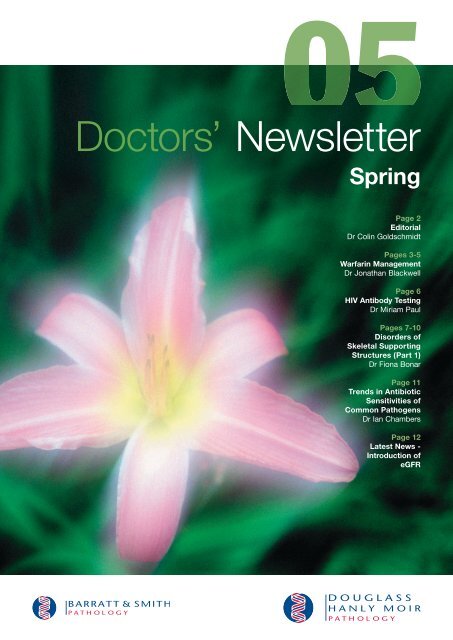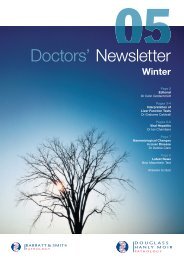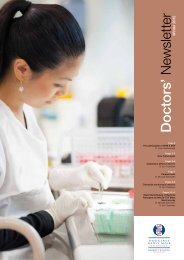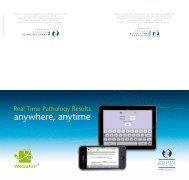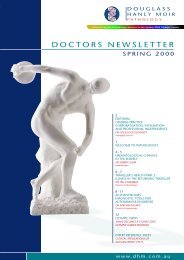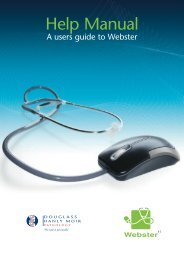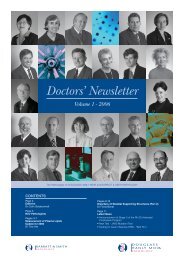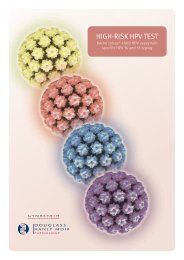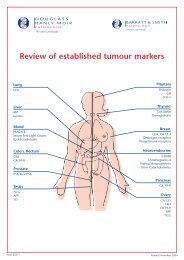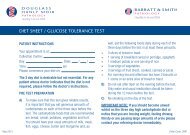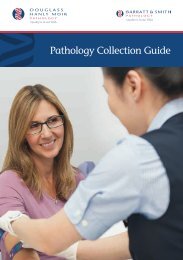NEWS(spring '05). - Douglass Hanly Moir Pathology
NEWS(spring '05). - Douglass Hanly Moir Pathology
NEWS(spring '05). - Douglass Hanly Moir Pathology
Create successful ePaper yourself
Turn your PDF publications into a flip-book with our unique Google optimized e-Paper software.
EditorialLaboratory QualityThe Heart of our PracticeDr Colin GoldschmidtChief Executive OfficerWelcome to the Spring 2005 Doctors’ Newsletter! In thisedition we offer review articles on INR management, HIVtesting, and the first of a two-part article on tendinopathies.INR and HIV tests both exemplify how crucial it is fora laboratory to achieve excellence and consistency indiagnostic testing. Both have in common potentiallyprofound implications for the patient, should the result beunreliable. Although these two tests are particularly goodillustrations, all laboratory results, of course, have importantimplications for patient management.Those who work in laboratories know how muchbehind-the-scenes effort is required of them to produceresults of a consistently high standard. Quality Control maynot be one of the most obvious features of the serviceyou receive but it is certainly one of our most importantactivities.At <strong>Douglass</strong> <strong>Hanly</strong> <strong>Moir</strong> <strong>Pathology</strong>, and at Barratt and Smith<strong>Pathology</strong>, we have always placed quality at the very heartof our existence as pathology practices.To take the INR as an example, in order to generatethe thousands of reliable INR results per year which weproduce, we must test a variety of control specimens manytimes during the working day, and then act immediatelyon any discrepancies. Results which are at variance froma patient’s previous result are repeated as a matter ofcourse, and if particularly unexpected or abnormal, may beassessed by a manual method as well as an automatedone. Abnormal results are always overseen by a seniorscientist or pathologist. In addition, the laboratories withinour organisation take part in regular inter-laboratory qualitycontrol exercises.Every investigation performed by our laboratory has its ownQuality Control scheme, tailored to the individual test toachieve the best result, and this includes our histopathologyreports. Regular external assessment of performance andparticipation in continuing education by all our pathologistsis vital to this activity.Performance in external Quality Control exercises is, ofcourse, one of the best objective measurements of quality.For more than 30 years, the Royal College of Pathologistsof Australasia has led the provision of well-organisednational proficiency testing. We are enthusiastic participantsin their schemes, and take pride in our success. NATAaccreditation adds a further layer to the external supervisionof quality of results.Of course, the final quality assessment lies with you, our“customers”, to whom we owe a great debt for discussingour service with us and for bringing to our attention anyapparent anomalies. We welcome every opportunity to dothis and are more than happy to repeat any investigationat your request if you feel the result does not appear to ‘fit’with your clinical assessment.Space does not permit me to expand further on our manyquality activities, however all of our pathologists, includingmyself, are happy to discuss any queries you may haveabout this aspect of our service.Meanwhile it remains for me to thank you very much foryour ongoing support.With my best wishes,Dr Colin GoldschmidtM.B.B.Ch., F.R.C.P.A., F.A.I.C.D.Chief Executive Officer<strong>Douglass</strong> <strong>Hanly</strong> <strong>Moir</strong> <strong>Pathology</strong>Barratt & Smith <strong>Pathology</strong>2
Warfarin ManagementWarfarin is one of the most commonly prescribed drugs.It is used as prophylaxis against thrombosis in the venousand arterial vasculature. It is effective in reducing the riskof thrombosis but has a narrow therapeutic window. Thereare only a few alternative drugs especially for long-termprophylaxis against thrombosis. Therefore the decision toanticoagulate a patient with warfarin is a decision to choosethe lesser of two evils.The therapeutic effect of warfarin is assessed with the INR(international normalised ratio for the prothrombin time). Theeffectiveness of warfarin has been shown in clinical trialsto be related to the INR, both the absolute level and thestability. Similarly, the side effects of warfarin therapy maybe related to high INR and variability of the INR.The rest of the article will concentrate on matters that mayinfluence the variability of the INR. The following are someof my thoughts about warfarin management that maybe helpful.Patient FactorsDoseDr Jonathan BlackwellHaematologistA forgotten a dose of warfarin is not infrequent. The patientshould not take extra, but be encouraged to be diligent withwarfarin doses. Testing too soon after the missed dosee.g. within three days, is likely to be misleading.I am sometimes asked why some patients require muchlarger doses of warfarin than others, i.e. seem to be“resistant” to warfarin. Genetic factors leading to differentmetabolism are increasingly recognised as a cause of widevariation in warfarin doses between patients. This type ofprofiling is still only used in clinical research.DietHigh dietary Vitamin K intake will reduce the INR. Greenleafy vegetables such as spinach, cabbage or cauliflowerare well known. Some cheeses, nuts and liver products areother foods high in vitamin K.Variation in the intake of Vitamin K rich foods from day today may lead to increased INR variability.Warfarin is well absorbed from the gut. Small bowel diseaseor poor oral intake will reduce the Vitamin K absorption andtherefore increase the INR.Malnutrition or intercurrent illness will affect warfarin proteinbinding and may increase the INR.AlcoholAlcohol consumption that is high and chronic may increasethe clearance of warfarin and therefore decrease the INR. Apatient with liver dysfunction will, however, have decreasedsynthesis of coagulation factors and therefore may haveincreased sensitivity to warfarin. Small regular amounts ofalcohol do not have a great influence on the INR.Understating alcohol consumption, particularly “bingeing”, isa common cause of variable INR.MedicationsMany drugs may potentiate warfarin and therefore increasethe INR.Some Drugs increasing the INRCotrimoxazoleErythromycinMetronidazoleIsoniazidAmiodaroneClofibrateOmeprazolePhenylbutazoneSome Drugs decreasing the INRCholestyramineRifampicinCarbamazepineSucralfateBarbiturates3
Warfarin ManagementOne of our Senior Scientists overseeing coagulation testing.5
HIV Antibody Testing6Dr Miriam PaulMicrobiologistTesting for HIV infection should be part of any investigationfor sexually transmitted disease. It is also recommendedby the College of Obstetricians and Gynaecologists as partof the routine antenatal screen, because perinatal infectionof the infant can be considerably reduced if appropriatepreventive measures are taken. Another setting where HIVtesting is important is in the follow-up of needlestick injuries.It is important that a pre-test clinical assessment of patientrisk factors be made and pre-test counselling undertakenregarding the interpretation of possible results andfollow-up.<strong>Douglass</strong> <strong>Hanly</strong> <strong>Moir</strong> <strong>Pathology</strong> is now using the combinedHIV antigen/antibody test for all samples, in order toprovide more sensitive detection of early infection. Thisis used as the initial screening test, with further testingautomatically done at a reference laboratory on samplesthat are not negative.Following an initial positive screening test, a secondscreening method is used. The sample also proceeds toWestern Blot testing, which allows the individual detectionof antibodies to ten HIV antigens. A sample containingantibodies to four or more antigens (“bands”) is consideredPOSITIVE.If Western Blot reactivity is present, but to fewer than fourantigens, the result is reported as INDETERMINATE. Thismay be due to cross-reactive antibodies, or to very earlyor very late HIV infection. In this patient group it is mostimportant to elicit a history of risk factors. In the antenatalpopulation, for instance, in whom very few patients haverisk factors, the rate of non-specific reactions in Sydney is1 in 500 women tested. In patients at risk, it is possible toretest as soon as two weeks later, as the Western Blot willusually develop more positive bands rapidly. A persistentlyindeterminate Western Blot result, which does not progressto become clearly positive over the course of three months,is due to non-specific reactivity and the HIV status can beregarded as negative.Further testing on patients with indeterminate HIV resultshas in the past included HIV PROVIRAL DNA testing.This detects the presence of HIV virus in the blood.Unfortunately, the only test licensed in Australia has beenwithdrawn by the manufacturer and an alternative may takeup to a year to become available. HIV viral load testing isnot recommended to confirm suspected early infection asfalse positive results have been reported.For positive HIV results, it is recommended that the test berepeated on a second blood sample for confirmation. Atthe same time, if staging of the infection is required, HIVviral load and T-cell subsets can also be requested, priorto referral for HIV specialist assessment and possibletreatment.With regard to post-exposure HIV testing (e.g. following aneedlestick injury or at-risk behaviour), seroconversion canbegin as early as three weeks afterwards and early testingmay be warranted in high-risk patients. The HIV antibodytest is very sensitive and a result six weeks post exposureis very reliable, although retesting, three months followingexposure, is still required for a definitive result.Health care professionals involved in exposure-proneprocedures are required by law to be tested for HIV,Hepatitis C and Hepatitis B (if non-immune) annually. Thismainly applies to those involved with surgical procedures,as the definition of “exposure-prone” is a matter of havinghands and sharp instruments together in a place with novisibility (e.g. abdominal cavity) with potential for an injuryinvolving the patient’s blood. It may apply to surgical scrubsisters and surgical assistants as well as surgeons. The testresults do not have to be disclosed to the professional’semployer due to privacy concerns, but if positive for HIV,Hepatitis C PCR, or Hepatitis B e antigen, the personinvolved must refrain from performing exposure proneprocedures, but may continue to perform other surgicalprocedures.There is no charge for medically-indicated HIV testing.HIV-1 VirionRNAReverseTranscriptaseSurfaceGlycoproteinTransmembraneGlycoproteinIf you have any enquiries, please do not hesitateto contact Dr Miriam Paul or Dr Ian Chamberson (02) 98 555 312
Disorders of Skeletal Supporting Structures (Part 1)Proposed Model For TendinosisIncreased demandon tendonAdaptionNormalAdaption"Chondroid"Metaplasia(misguided adaption)Increased groundsubstanceDecreased collagenproductionCollagendegeneration+/- tearInadequate repairFibroblasticMyofibroblastic/Proliferation+/- further trauma RepairPredisposition tofurther injuryEnd-Stage TendinosisThere is a gradual transition from normal to abnormal andin the case of tendons in which changes are maximal at theinsertion site (e.g. patellar tendon) there may be a degreeof disruption of the tendon-bone interface, with remodellingat that site suggesting an associated tug lesion, sometimesrepresented by small fragments of bony debris (this findingprobably explains the “hot” bone scan identified in a subsetof these patients). In tendons in which the symptomaticarea is away from the tendon insertion (e.g. Achillestendon), the changes are seen at that site (approximately5cm proximal to the calcaneal insertion site).Macroscopically, the affected area is thus expandeddue to the increased tissue mucin (proteoglycan). Thecollagen bundles are more amorphous in their orientationand are susceptible to disintegration. This accounts forthe characteristic radiological findings, noted onMRI and ultrasound in particular. There is thickening ofthe component tendon and peritendinous tissue, withelongated spaces within the bundles representing theincreased mucoid ground substance splitting the collagenbundles. MRI exhibits increased signal intensity designated“oedema”, essentially representing the increased myxoidmaterial within the tissues.The adaptive change in the tenocytes is also manifest ashistiocytic/macrophage differentiation in the componentcells, supported by recent molecular data. This is a likelysource of the attendant inflammatory phenomenaseen clinically.The process reflects an intrinsic alteration in the tenocytesand surrounding “inert” paratendinous mesenchymal cells,reflecting a degree of divergent differentiation apparentlyprecipitated by altered mechanical circumstances. Thisis supported by the fact that experimental studies havedocumented this phenomenon quite elegantly. In tendons,the changes initially reflect adaptive phenomena which, withongoing insult, is ultimately deleterious for the structureas the collagen disintegrates and can no longer transmittension effectively.Ultimately, irreversible damage ensues. The processmight be altered by mechanical means so that fibroblasticand myofibroblastic (collagen-producing) differentiationpredominates, promoting repair.The concept that the connective tissue cells are altered bymechanoreceptive processes is supported by the fact thatthe most effective treatment modalities are those which alterthe basic biomechanical abnormality. The long term benefitof NSAIDs and intratendon steroid injection has never beenconfirmed in a controlled study environment and steroidinjection may precipitate tenonecrosis. Surgery is retainedfor the most recalcitrant cases.In a forthcoming newsletter article, Dr Bonarwill discuss specific disorders, including calcifictendinitis, bursitis, carpal tunnel syndrome,plantar fasciitis and others.9
Disorders of Skeletal Supporting Structures (Part 1)Long axis colour Doppler ultrasound image ofchronic Achilles tendinosis. Note abnormal fusiformswelling of proximal tendon segment with multipleintrasubstance echogenic foci (calcifications) castingacoustic shadows. Areas of colour within the tendondenote accompanying hyperaemia and usuallyindicate a symptomatic (painful) tendon.Treatment ModalitiesLoad reduction/relative restBiomechanical correction- braces/supports- orthotic devices- technique correction- strengthening (eccentric regimens)Massage- ultrasound- laser- heat- extracorporeal shock wave therapy? fibroblaststimulationCryotherapy -decreased metabolic rate/metabolites/extravasated redblood cellsDrugs- NSAIDs - ? increased collagen synthesis- steroids - (tenonecrosis)- protease inhibitors- low dose heparin affect fibrin depositionMRI of Achilles tendinosis. Image shows fusiformthickening of the proximal Achilles tendon segmentwith an underlying zone of poorly-marginatedlow-grade degenerative intrasubstance signalhyperintensity.SurgeryMolecular biology/gene manipulation (in the future)If you have any enquiries, please do not hesitateto contact Dr Fiona Bonar on (02) 98 555 15410
Trends in Antibiotic Sensitivities of Common PathogensDr Ian ChambersDirector of MicrobiologyUrinary Tract PathogensE.coli continues to be the commonest uropathogen in bothoutpatient and inpatient settings, and the great majority remainsensitive to cephalexin, amoxycillin-clavulanate combinations,nitrofurantoin and norfloxacin. An increasing number of isolates(mostly causing infection in hospitalised patients or those withcomplicated urinary tracts) produce an extended-spectrumbeta-lactamase (ESBL). ESBL-producers are resistant to latergenerationcephalosporins such as cefotaxime and ceftazidime,and they are often resistant to other classes of antibiotics suchas aminoglycosides and quinolones. E.coli is the commonestESBL-producer isolated in this laboratory, but Enterobacterspecies and Klebsiella species also have this potential.URINARY TRACT PATHOGENS (% SENSITIVE)ORGANISM Ampicillin Cephalexin Amox/Clav Acid Norfloxacin Trimethoprim NitrofurantoinE.coli 49 95 95 97 81 96S.saprophyticus 100 100 100 100 96 99Proteus species 88 88 92 96 84 0K.pneumoniae 0 93 93 96 86 82Enterococcus species 99 – 99 – – 99Respiratory Tract PathogensStreptococcus pyogenes (Group A Strep) remains exquisitely sensitive to penicillin, but 10 days treatment is recommendedin order to achieve clearance of the organism from the pharynx and prevent relapse. Reduced penicillin-sensitivity inS.pneumoniae continues to be observed, but is not usually of clinical significance when isolated from respiratory specimens.Increased oral dosage, or parenteral administration for more severe infection, effectively treats most cases.In view of the ongoing pertussis outbreak, a reminder may be useful that Australian recommendations (for both treatment andprophylaxis) are clarithromycin or erythromycin for 7 days. The alternative antibiotic for patients who cannot be given theseagents is cotrimoxazole.RESPIRATORY PATHOGENS (% SENSITIVE)ORGANISM Pen/Amp/Amox Amox/Clav Acid Tetracycline ErythromycinH.influenzae 62 100 87 –S.pneumoniae 91 91 75 82M.catarrhalis 44 100 100 92Soft Tissue PathogensApproximately 20% of our Staphylococcus aureus isolates, overall, are methicillin-resistant (and therefore resistant toflucloxacillin, dicloxacillin, cephalosporins, etc). The majority of these are non-multi-resistant S.aureus (also referred to ascommunity acquired MRSA, or cMRSA). Orally-administered antibiotic options for infection caused by these organisms includecotrimoxazole, clindamycin and doxycycline. Importantly, many of these strains of S.aureus produce a toxin known as PantonValentine Leucocidin (PVL) which is associated with tissue necrosis, abscess formation and severe pneumonia. Promptrecognition and appropriate treatment of such infections is vital.The prevalence of penicillin and ciprofloxacin resistance in NSW isolates of Neisseria gonorrhoeae (46% and 47% respectively)should preclude their selection as empiric treatment. Isolates with reduced ceftriaxone susceptibility have been detected inNSW but have not been associated with treatment failure. (Data from Gonococcal Surveillance Unit, Prince of Wales Hospital.)SOFT TISSUE PATHOGENS (% SENSITIVE)ORGANISM Penicillin Erythromycin Tetracycline CiprofloxacinS.pyogenes 100 97 94 –S.aureus (methicillin-sensitive) 18 89 92 –Ciprofloxacin Rifampicin Fusidic Acid Vancomycin Clindamycin CotrimoxazoleCommunity-Acquired MRSA 90 100 97 100 75 99Multi-resistant MRSA 12 99 99 100 0 12Penicillin Ciprofloxacin Spectinomycin CeftriaxoneN.gonorrhoeae 54 53 100 10011
Latest News - Introduction of eGFRAddition of ‘Estimated Glomerular Filtration Rate’ to Biochemistry ReportsFrom 5th September 2005, a value for estimated glomerular filtration rate (eGFR) using the MDRD formula has been includedat no charge on our reports whenever serum creatinine is requested for all patients who are 18 years and over.It is anticipated that provision of the eGFR value based upon serum creatinine measurement and the patient’s age and gender“will lead to a vast increase in detection of chronic kidney disease in Australia” 1 .Previously, changes were made to our reporting of creatinine results in September 2004. The addition of automatic reportingof eGFR to these earlier changes ensures that our practice is fully compliant with the recommendations contained inthe Position Statement of the Australasian Creatinine Consensus Working Group 2 published on 1st August 2005. Itis important to note that there are a number of conditions where use of the MDRD formula is not appropriate for glomerularfiltration rate estimation as shown in the reference material below 3 .Further details about conditions that apply to eGFR interpretation and recommendations concerning patientfollow-up are available at the Kidney Health Australia website (www.kidney.org.au).1 Chadban SJ, Ierino FL. Editorial – Welcome to the era of CKD and the eGFR. MJA 2005; 183 (3): 117-118.2 The Australasian Creatinine Consensus Working Group. Chronic kidney disease and automatic reporting of estimated glomerular filtration rate: a positionstatement. MJA 2005; 183 (3): 138-141.3 Kidney Health Australia 2005 eGFR GP Desktop Resource Card - reproduced in part with permission.KIDNEY HEALTH AUSTRALIA GUIDELINESCHRONIC KIDNEY DISEASE (CKD) & eGFReGFR ACTION PLANIf you have any questions about our reporting of eGFR, please do not hesitateto contact Dr Grahame Caldwell on (02) 98 555 312DOUGLASS HANLY MOIR PATHOLOGY • ABN 80 003 332 858A subsidiary of SONIC HEALTHCARE LIMITEDBARRATT & SMITH PATHOLOGYA trading name of DOUGLASS HANLY MOIR PATHOLOGY PTY LTD • ABN 80 003 332 858A subsidiary of SONIC HEALTHCARE LIMITED95 EPPING ROAD • MACQUARIE PARK • NSW 2113 • AUSTRALIATEL 98 555 222 • FAX 9878 5077MAIL ADDRESS • LOCKED BAG 145 • NORTH RYDE • NSW 1670 • AUSTRALIA31 LAWSON STREET • PENRITH • NSW 2750 • AUSTRALIATEL 4734 6500 • FAX 4732 2503MAIL ADDRESS • PO BOX 443 • PENRITH • NSW 2751 • AUSTRALIA


